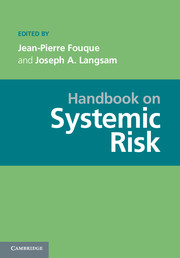Book contents
- Frontmatter
- Contents
- Contributors
- Introduction
- PART I DATA: THE PREREQUISITE FOR MANAGING SYSTEMIC RISK
- PART II STATISTICS AND SYSTEMIC RISK
- PART III MEASURING AND REGULATING SYSTEMIC RISK
- PART IV NETWORKS
- PART V SYSTEMIC RISK ANDMATHEMATICAL FINANCE
- PART VI COUNTERPARTY RISK AND SYSTEMIC RISK
- PART VII ALGORITHMIC TRADING
- PART VIII BEHAVIORAL FINANCE: THE PSYCHOLOGICAL DIMENSION OF SYSTEMIC RISK
- PART IX REGULATION
- PART X COMPUTATIONAL ISSUES AND REQUIREMENTS
- PART XI ACCOUNTING ISSUES
- References
32 - Accounting's Role in the Reporting, Creation, and Avoidance of Systemic Risk in Financial Institutions
from PART XI - ACCOUNTING ISSUES
Published online by Cambridge University Press: 05 June 2013
- Frontmatter
- Contents
- Contributors
- Introduction
- PART I DATA: THE PREREQUISITE FOR MANAGING SYSTEMIC RISK
- PART II STATISTICS AND SYSTEMIC RISK
- PART III MEASURING AND REGULATING SYSTEMIC RISK
- PART IV NETWORKS
- PART V SYSTEMIC RISK ANDMATHEMATICAL FINANCE
- PART VI COUNTERPARTY RISK AND SYSTEMIC RISK
- PART VII ALGORITHMIC TRADING
- PART VIII BEHAVIORAL FINANCE: THE PSYCHOLOGICAL DIMENSION OF SYSTEMIC RISK
- PART IX REGULATION
- PART X COMPUTATIONAL ISSUES AND REQUIREMENTS
- PART XI ACCOUNTING ISSUES
- References
Summary
Abstract The financial crisis that erupted in late 2007 has resurfaced debates about the role of accounting and external financial reporting by financial institutions in helping detect or mask systemic risks and in exacerbating or mitigating such risks. The debate has largely focused on the role of fair value accounting, securitization and special purpose entities, off-balance sheet reporting and pro-cyclicality. We consider these and other issues using a single company's published accounts. We explain the role, purpose and limitations of external financial reporting and suggest that there are aspects of the current accounting system that may help provide early warnings of and help mitigate potential systemic risks and others that may mask and exacerbate these risks. We offer some ideas on how the accounting might be adjusted to mitigate the latter. Our arguments lead to several conclusions the most important of which include: that credit-related crises are at least partly induced by not requiring financial institutions to take credit valuation adjustments on loans based on expected losses, and that disclosures would have to change significantly to allow an investor or regulator to make a realistic attempt at measuring a firm's risk and even more so any potential systemic risk. But there is no way that an accounting system that is based on measurements at a single point can serve to fully identify and capture the uncertainty and risks. We believe that to be able to assess systemic risk even for a single firm we would need massive amounts of detailed data that few market participants would be able to utilize and interpret. At best the system can provide more disclosures to facilitate the understanding of such risks.
- Type
- Chapter
- Information
- Handbook on Systemic Risk , pp. 918 - 964Publisher: Cambridge University PressPrint publication year: 2013
References
- 6
- Cited by



